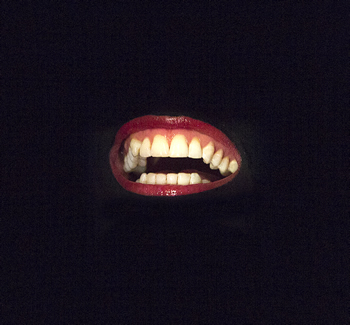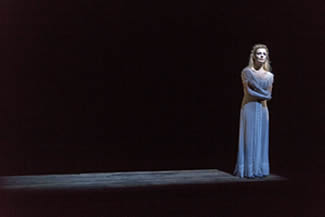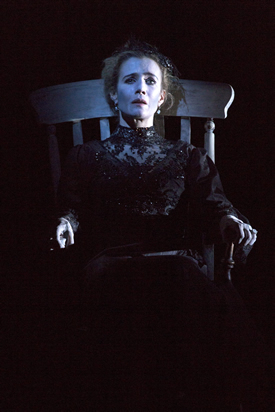
Little Big Beckett
By Jonathan Kalb
Not I, Footfalls, Rockaby
By Samuel Beckett
BAM Harvey Theater
651 Fulton St., Brooklyn
TICKETS
Lisa Dwan deserves all the accolades that have come her way for the three late Beckett plays now visiting BAM from the Royal Court in London. No one has done Not I, Footfalls and Rockaby this powerfully or sensitively in a very long time. And having seen all the 1980s performances by Billie Whitelaw with which Dwan’s have been everywhere compared, I can affirm that she is a comparably rare find. (Whitelaw generously advised Dwan on this performance.)
Dwan’s triumph here comes not just from her searing physical presence and wonderful feel for the rhythms and textures of Beckett’s writing but also from her general attitude. Unlike so many other first-rate actresses who have done these plays in recent years to far lesser effect (the late Marian Seldes and Kathryn Hunter, for instance), Dwan understands the importance of her actual stress—even distress—to the artistic equation. Her director Walter Asmus, a veteran Becketteer, is quoted in the program warning her: “it’s coming too easy to you—it needs to cost you more, we need to see you bleed up there.” Indeed we do.
For all its notoriety and familiarity from the film of Billie Whitelaw’s performance, Not I is rarely produced in the theater. I’ve seen this play only twice, both times ineptly done. It features a disembodied mouth rambling on at the speed of thought, and the practical problems of properly anchoring the actress’s head, isolating and masking the mouth, and memorizing and delivering the monologue are alone daunting enough to dissuade the heartiest. Dwan and Asmus solved these issues handily and then aimed for a speed record. Their version runs eight and a half minutes. Whitelaw’s was twelve.

The sense of existential panic is palpable and dreadful with Dwan’s torrent. It’s as if we were witnessing the aftereffect of a devastating psychic explosion that literally and figuratively fragmented the character before the play began. This explosion is usually presumed to be birth—“tiny little thing . . . before its time . . . godforsaken hole . . . no love . . . spared that”—regarded as a sort of punishment. But such a blast of words isn’t meant to be followed, only endured, by speaker and listeners, felt penitentially as it were as a sort of frantic plaint spat out at both us and whatever unearthly agency was presumptuous enough to wrest such a being out of nonexistence and plant her in “this world.” Utterly alien in such a place, she is condemned to wander and suffer, with a ceaseless “buzzing” and “begging” in her brain preventing her from ever properly apprehending a self.
Not I was written to have a second character, a hooded figure called Auditor who haplessly flaps his/her arms each time Mouth vehemently “[refuses] to relinquish third person”: “what? . . “who? . . no! . . she!” This character is frequently omitted and doesn’t appear in Dwan’s production, which consequently has no need to light any space apart from the mouth. As already mentioned, the masking around the mouth is very carefully done, absorbing all but the most diffuse spillover from the single pinspot used to illuminate it.
Yet even that diffuse spillover turns out to be important and resonant, as it adds shading to the play’s leitmotif of deracination. Dwan’s mouth sometimes seems to move in space, up and down and side to side, as her chin pulses and changes angles. Ghostly outlines also form around it, extending ten feet or more in every direction, now (as I saw it hypnagogically) a giant hand with extra fingers, now a grotesquely distorted face. Illusions of still more unreachable selves, or companions, or partial selves, partial companions, like those hinted at in the text: “middle of the throng . . . motionless . . . staring into space.”
Dwan’s performance is also distinguished by the selected moments of sudden anger and aggression she injects into her speeches in all three plays, emphases entirely her own that suggest specific character traits and hence vie pointedly with the presumed characterlessness of the figures. Her “vehement refusals,” for instance (the words “no . . . she” in in Not I’s “what? . . “who? . . no! . . she!” refrain), are punched out especially hard, implying that that act of self-denial is a sort of petulant obsession with her. In Footfalls, her punched phrases include “so little” and “it all,” signaling special resentment at the idea of youth and bodily health, and contempt for the prospect of concrete existence. Dwan uses her own recorded voice for May’s mother in Footfalls, altered to sound gravelly and aged, and at times she moves her mouth along with the tape. This is yet another strange and original effect, which adds marvelously to the general ghostliness and blends with the numerous repetitions of “time she stopped” by the “prematurely old” woman named W in Rockaby.

Asmus and Dwan’s Rockaby is as subtle, carefully modulated and gripping as this play has ever been. The four “mores” are like scraped bowstrings, heartbreakingly plaintive and distinctly doubtful at the last. The rocking chair, angled and about eight feet off center, rocks notably slower than I’ve seen it before and moves in very dim light, so that Dwan’s face almost wholly disappears on the back rocks and is never more than half lit on the forward ones. Only when the chair stops on the “mores” is her head completely lit, and also when it falls with indeterminate finality at the end, her face an ambiguous mask of grief, despair and relief rolled into one.
For all this achievement, it must be said—emphatically—that these plays are not well served by a theater as large as the 834-seat BAM Harvey. The Royal Court (capacity 465) where they originated was itself too large to do them full justice, certainly for viewers in the rear, because not enough detail can possibly be discerned in the stage compositions. All Beckett’s late plays require a particular theatrical encounter to carry at full power: they must present a punctiliously crafted picture, a precise stage tableau upon which viewers may meditate as they consider what relation it bears to the flow of ambiguous words emanating from it. Yet beyond, say, row L at the Harvey Dwan’s Mouth is so small it looks like little more than a quivering red dot. Hence all its qualities of allure and horror must be inferred, or taken on faith. The vocal recordings in all three plays are also too hushed to be properly heard throughout the Harvey. This is not a new problem, alas. These same complaints were widely heard when Not I had its American premiere in 1972 at the 299-seat Forum Theater (now the Mitzi Newhouse) at Lincoln Center.
I am not among those prepared to write off this sort of loss as an acceptable adjunct to Beckett’s growing classicism and popularity. There are other ways to give thousands access to the work. In 1984, Whitelaw performed Footfalls and Rockaby for two months at the 99-seat Samuel Beckett Theatre on Theatre Row, and would have continued had ticket sales thrived. The previous year, David Warrilow performed Ohio Impromptu, Catastrophe and What Where at the 99-seat Harold Clurman Theater 350 times, over ten months. In other words, most people who wanted to see these plays, saw them back then because the artists and producers dedicated themselves to long runs. And everyone who was there could distinguish every unforgettable murmur, facial crease, gesture and final breath.
